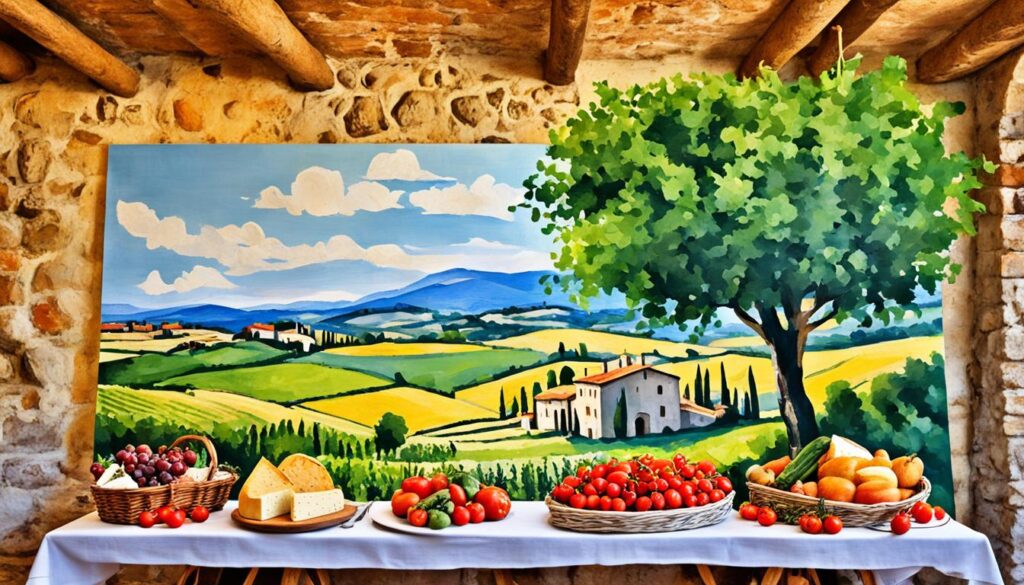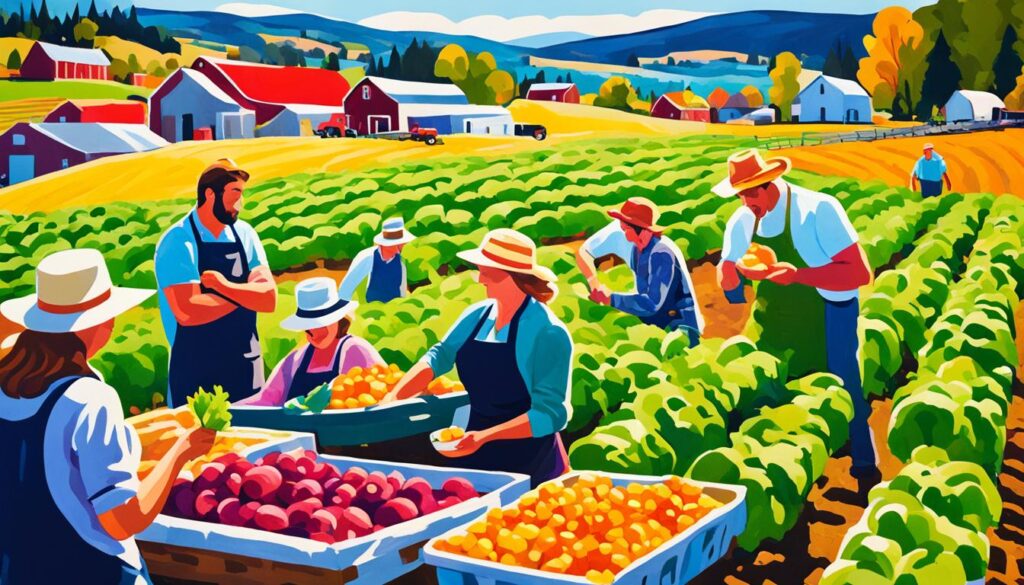The world’s food is more industrialized than ever. But there’s a call to go back to the beginning – agritourism and slow food. These ideas give us a break from busy life. They let us enjoy the tastes from the land and meet those who grow our food.
Agritourism is more than just visiting places. It’s about understanding the hard work behind each artisanal product. You get to see vineyards and small farms up close. It shows the beauty of sustainable agriculture and why we should keep old traditions alive.
Linked to agritourism is the slow food movement. It’s a way to eat that values where our food comes from. This means enjoying food that’s fresh, local, and in season. With every meal, we appreciate farmers’ efforts and the variety of agricultural experiences worldwide.
If you love food or you’re eager to make real connections, agritourism and slow food invite you to a special journey. It’s where eating becomes a story, and each meeting shows us beauty in the little things. Let’s explore together, supporting local food and meeting the people behind it.
Key Takeaways
- Agritourism invites us to explore rural landscapes and witness sustainable agricultural practices firsthand.
- The slow food movement promotes mindful consumption, savoring locally sourced, seasonal ingredients.
- Embracing agritourism and slow food offers genuine connections with farmers and local communities.
- These movements support artisanal production, culinary traditions, and environmental sustainability.
- Engaging in agritourism and slow food provides an enriching experience for foodies and conscious travelers alike.
What Is Agritourism?
Agritourism is a mix of farming and tourism. It pulls people to farms for fun and to learn. This helps farm owners make money while offering visitors a great time.
Definition and Overlap with Gastronomy Tourism
It often meets gastronomy tourism. This means people tour farms for good food experiences. Wine tourism is similar. It includes tours and tastings at vineyards and wineries.
Smaller-Scale, Organic Farms and Local Food Systems
A lot of these farms are small and organic. They focus on local food systems, which are more earth-friendly. These farms help us eat fresh, healthy food and protect the planet.
Principles of Mindful Consumption and Sustainability
Agritourism is about wise eating and living gently on the earth. It teaches visitors to value where their food comes from. By showing farming life up close, it grows love for the earth and its keepers.
Agritourism Activities and Offerings
Exploring agritourism has led me to amazing experiences. These activities let visitors deeply connect with the land. There’s a lot to do, from educational farm tours to cooking classes. Everything is designed to bring the farm-to-table idea to life.
Farm Tours and Educational Experiences
Educational farm tours are a big hit in agritourism. They show what small-scale, organic farming is all about. I’ve visited fields, seen crop rotation in action, and learned about the importance of different plants. The farmers are so passionate and love to share what they know.
Dining and Lodging on Working Farms
Some agritourism spots go further, offering farm stays and farm-to-table dining. I loved enjoying meals made with just-picked ingredients on the farm. It’s a peaceful break from everyday life. Staying overnight meant I could really feel the farm’s natural rhythm.
Diverse Spectrum of Hospitality, Recreation, and Direct Sales
Agritourism has something for everyone. You can volunteer on farms or join in on work exchanges. Enjoy culinary trails or try food and wine pairings. Many places also have events like harvest festivals and farmers’ markets. It’s a chance to support local farmers and take some of your experience home.
| Activity | Description |
|---|---|
| Farm Tours | Guided tours of working farms, offering insights into sustainable farming practices and local food production. |
| Cooking Classes | Hands-on culinary experiences, teaching traditional recipes and techniques using fresh, locally sourced ingredients. |
| Farm Stays | Overnight accommodations on a working farm, providing an immersive experience in rural life and sustainable living. |
| Farm-to-Table Dining | Restaurants, cafes, or on-farm dining experiences featuring locally grown, seasonal produce and farm-fresh ingredients. |
Are you looking for something educational, a culinary adventure, or just want to relax in nature? Agritourism offers great chances to live more sustainably and mindfully.
Agritourism and Sustainable Development
Agritourism, especially when it involves regenerative farming, drives sustainable development. It offers not only economic benefits, but also social, cultural, and environmental ones. This makes it a worldwide force for good.
Economic Benefits: Income Diversification and Job Creation
Agritourism helps local economies by providing extra income for farmers and rural areas. It also creates jobs when people connect with local producers. This boosts the local economy and supports growth.
Social and Cultural Impacts: Preserving Traditions and Cultural Exchange
Agritourism is key in keeping local traditions alive and sharing cultures. Tourists learn about the places they visit through culinary experiences. This keeps traditions alive and builds understanding among cultures.
Environmental Sustainability: Sustainable Land Use and Biodiversity Preservation
Agritourism promotes sustainable land use and helps preserve biodiversity. It uses eco-friendly farming to lessen the harm of industrial farming. This approach lowers carbon footprints and strengthens our bond with nature.
Agritourism is more than just seeing rural beauty. It’s about helping save our Earth’s resources and the unique cultures behind them.
| Economic Benefits | Social and Cultural Impacts | Environmental Sustainability |
|---|---|---|
| Income diversification | Preserving local traditions | Sustainable land use practices |
| Job creation | Cultural exchange | Biodiversity preservation |
| Supporting local economies | Culinary heritage promotion | Regenerative agriculture methods |
This graph shows how agritourism benefits communities in many ways. It supports the economy, culture, and the environment, leading to sustainable growth globally.
Case Studies in Agritourism
Agritourism is a fast-growing industry. It blends unique tourism experiences with care for the environment and local culture. I want to introduce you to some examples that show the amazing impacts of this way of traveling.
La Ferme Tarenti, Tunisia: Super-Organic Practices and Community Involvement
La Ferme Tarenti in Tunisia is a top spot for agritourism. It was started by a farmer who was the third in his family. The farm is well known for using farming methods that are super-organic. They don’t just stop there. They teach people about farming, have a place where you can enjoy local foods, and run workshops on making cheese.
This farm does a lot for its community. It gives jobs to many people and helps local artists and businesses. If you like helping out, they also have a spot for volunteers. This really helps in making the area feel like a big family.
Tenuta di Spannocchia, Tuscany: Authentic Farm Experience and Cultural Preservation
Tenuta di Spannocchia in Tuscany, Italy, is special because it has a long history. It started as a sharecropping farm and is now a place that shows how to live off the land in a natural way.
If you visit, you can really get into the farm life. You might sleep there, eat fresh food at the farm’s restaurant, or join in a farm tour. They have learning programs, too. This farm is all about keeping culture alive and using the land well.
Jardin d’Agaves, Tunisia: Organic Farming and Local Community Connections
Jardin d’Agaves is a new project in Tunisia that is a mix of a farm, a place to eat, and a beautiful natural space. They work hard to farm in an organic way and get their supplies from local farmers.
At this place, you can take tours, eat food that mixes Mexican and Tunisian flavors, and see the good things the farm does for the area. By offering jobs at different times of the year, the farm becomes a big part of the local community’s life and growth.
These stories about agritourism show how important it is for the world. They help save the planet, keep old ways of life going, and make communities stronger. When we visit these places, we are part of making the world a better place.
The Slow Food Movement: A Culinary Revolution
In a world dominated by fast food, Italian enthusiasts started a culinary revolution. The Slow Food Movement began in 1986. It was a reaction against food becoming too similar everywhere. They wanted us to value traditional food production methods, fresh seasonal ingredients, and protect food biodiversity.
Origins and Principles of Good, Clean, and Fair Food
The Slow Food Movement started in Italy. It aimed for food to be good, clean, and fair. This meant caring about quality, flavors, and well-being (good). It also included using sustainable farming with little harm to the earth (clean). And, it focused on fair pay for those who make our food (fair). People who care about where their food comes from and its impact on the world found this idea special.
Preserving Food Biodiversity and Traditional Knowledge
The Slow Food Movement is deeply committed to preserving biodiversity and traditional food production methods. Its global network works with local farmers to protect rare plants, animals, and food-making ways. It helps keep old food and cooking styles going, teaching young people important cultural practices.
“The Slow Food Movement is not just about defending the taste of authentic dishes; it is about defending the human beings who create them, the cultures from which they are born, and the links between gastronomy and ecology.” – Carlo Petrini, Founder of Slow Food Movement
Joining the slow food movement philosophy means loving seasonal fresh ingredients. It’s also about respecting the many food cultures carried from one generation to the next. This movement invites us to slow down, enjoy the food-making process, and welcome the variety that feeds our body and soul.
Agritourism and slow food in Italy
Italy is known as the home of the Slow Food Movement. It has mixed this philosophy with its deep passion for food. This has boosted local dishes and spread earth-friendly farming methods. The movement has been key in keeping Italy’s many local cuisines true to their roots by backing old ways of food making and preparing.
Birthplace and Vibrant Playground of the Slow Food Movement
Italy’s rich food history and love for fresh, seasonal ingredients birthed the Slow Food Movement. It hosts unique communities and presidia, all focused on safeguarding a special ingredient, technique, or food variety.
Safeguarding Regional Cuisines and Sustainable Farming
The Slow Food Movement has helped keep local cuisine alive by encouraging ancient farming and featuring small, earth-friendly farms. This approach keeps the real taste of each region while holding on to centuries-old cooking ways.

Agritourism and Culinary Tourism Opportunities
The Slow Food Movement has given Italy’s agritourism a big push. Now, many farms welcome visitors with farm stays, cooking lessons, and tours. These visits let people meet local farmers, discover how food is made traditionally, and enjoy the real food of Italy.
| Region | Traditional Dish | Agritourism Offerings |
|---|---|---|
| Tuscany | Bistecca alla Fiorentina | Vineyard tours, wine tastings, farm stays |
| Sicily | Arancini | Olive oil tastings, cooking classes, farm tours |
| Emilia-Romagna | Parmigiano Reggiano | Cheese-making workshops, dairy farm visits |
Want a real foodie escapade or to truly understand Italy’s farming legacy? The Slow Food Movement alongside the agritourism sector offers an exclusive chance. It lets you dive deep into the tastes, histories, and environment-friendly methods that set Italian food apart.
Embracing the Slow Food Movement
Travelling in Italy led me to love the Slow Food Movement. It has connected me with local people and their special tastes. This way of eating lets me enjoy Italy’s fresh, seasonal food. I contribute less to pollution and taste the real flavor of each meal.
Appreciating Local, Seasonal Produce
The best part of Slow Food is learning about how food grows the right way. I’ve visited farms and joined workshops, seeing the love put into growing Italy’s fruits and veggies. This makes me truly value what’s on the market and my plate.
Learning Traditional Cooking Techniques
Exploring Slow Food has also taught me old cooking methods. Thanks to local chefs, I can keep Italy’s food traditions alive. I’m happy to help share these delicious practices with others and keep Italy’s food culture strong.
Connecting with Local Communities
This movement has helped me mingle with local folks in a special way. I’ve been to food events, farms, and cooking classes. It’s an amazing chance to meet like-minded people who care about the Earth and Italy’s traditions.
Supporting Local Economies and Fair Trade
Being in the Slow Food Movement means I support local businesses and fair deals. Buying from small farmers and craftsmen supports their hard work. It means I get the best ingredients and help those who care for the Earth.
Joining the Slow Food Movement as an Italian has been life-changing. It’s shown me a beautiful and eco-friendly way of living. I eat food that’s true to Italy while working towards a better future for us all.
Case Studies: Slow Food Movement in Italian Communities
Italy is a diverse country known for its amazing food. The Slow Food Movement plays a big role in preserving local food culture across different regions. We will look at three special cases that highlight how this movement protects local flavors and helps communities.
Pecorino Cheese in Sardinia
In Sardinia’s beautiful landscapes, the Slow Food Presidium has rejuvenated the making of Pecorino cheese. They focus on sustainable farming and help local cheese makers. This project has not only saved a tradition but also boosted Sardinia’s economy. The renowned Pecorino cheese Sardinia is a symbol of the island’s resilience.
San Marzano Tomato in Campania
The San Marzano tomato grows in the sunny fields of Campania. The Slow Food Presidium there has kept its farming methods traditional. This ensures its unique taste and quality. Farmers now earn fair prices and have global recognition. The famous San Marzano tomato Campania is a sign of the movement’s support for local businesses.

White Truffle in Piedmont
Piedmont is known for its gastronomic delight, the white truffle. The Slow Food Movement has highlighted this gem. Their focus on sustainable harvesting has increased global interest. Both locals and international food lovers take pride. The white truffle Piedmont is a key example of how the movement protects traditional foods.
| Region | Traditional Product | Slow Food Impact |
|---|---|---|
| Sardinia | Pecorino Cheese | Revived production, sustainable farming practices, platform for artisanal producers |
| Campania | San Marzano Tomato | Preserved traditional cultivation methods, unique flavor, fair prices for farmers |
| Piedmont | White Truffle | Global attention, boosted tourism, fostered pride in culinary heritage |
These stories highlight the Slow Food Movement’s significant work in Italy. By encouraging sustainable, fair trade practices, and local food appreciation, the movement helps keep Italy’s food culture alive. It’s a celebration of Italy’s varied culinary traditions.
The Slow Food Way of Life
The Slow Food Movement began in Italy and grew worldwide. It’s more than just how we eat – it’s a way of life. This lifestyle values taking things slow, using sustainable methods, and saving food traditions. I joined and now I have a deep connection with Italy’s food heritage. I help local communities and work for a better planet.
Slow Living and Sustainable Practices
Being part of the Slow Food Movement means living mindfully. It’s about enjoying every moment and understanding the journey is as important as the end. This way calls for a slower pace, being close to nature, and using practices that care for our Earth and those who live on it. I love the simple life it teaches, the joy of local foods, and reducing waste.
Preserving Traditional Knowledge
It focuses on keeping old food knowledge alive, essential for our food culture. I’ve learned secret recipes and methods from skilled cooks and grandmothers. This has grown my respect for the knowledge they’ve shared. By keeping these traditions, we honor our past and let others enjoy the true taste of their heritage.
Celebrating Italy’s Culinary Heritage
Joining has opened the door to Italy’s food traditions. I get to enjoy local food events, wine tastings, learn about different food regions, and support small farms. I’ve seen meals turn into something magical, connecting people, culture, and the Earth’s gifts. This lifestyle has turned eating into a beautiful way of bonding, sharing stories, and finding joy in a diverse food culture.



